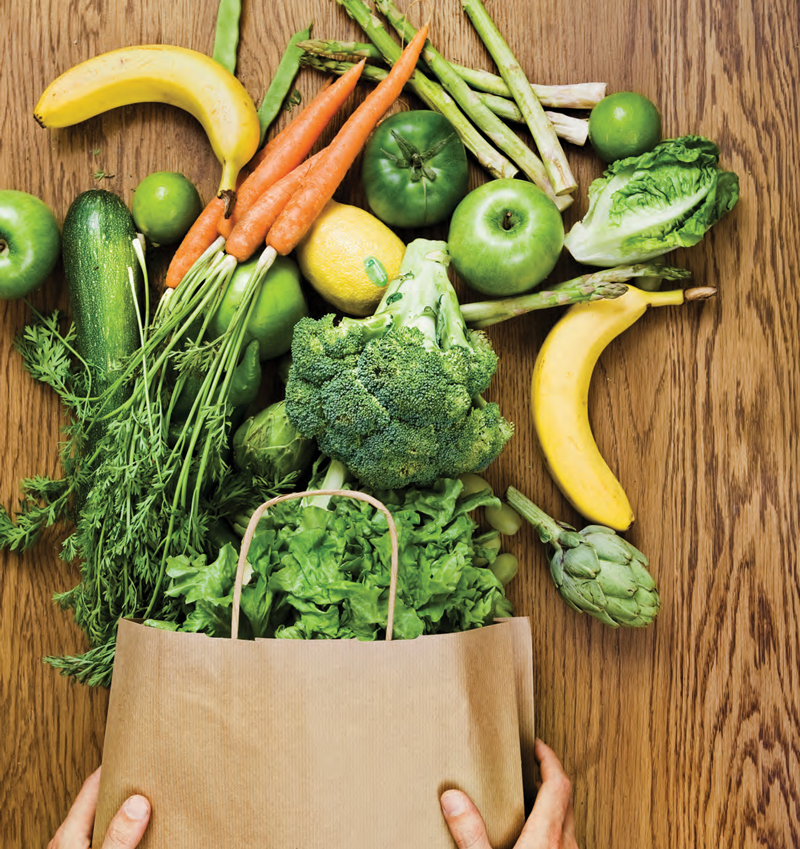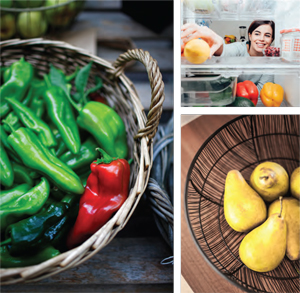Grocery Strategies | Simple Tips to Reduce Your Family’s Food Waste


Unless you have groceries delivered to your door, making a trip to the supermarket is a constant chore. And whether you make the trip or someone else does, we’d all like to reduce the time, money, and food wasted, while still providing delicious meals for our families. There are several practical ways to save these valuable resources throughout the meal planning, preparation, and storing stages of your weekly grocery routine.
Alternate uses for leftovers
When preparing meals, you’ll encounter scraps of fruits and vegetables after they have been peeled or chopped, bones or remnants of meat which cannot be added directly to a recipe, and many other items which can leave you turning to the trashcan in frustration. Instead of tossing these items, there are clever ways to utilize them, maximize waste management project while also saving money.
FRUITS AND VEGETABLES Toss fruit, such as overripe bananas or soft berries, into a large bag in the freezer. When you have gathered enough, blend these fruits with some sour cream, yogurt, or ice cream for a smoothie. There’s so many greens amazon to choose from that you can add for a healthier smoothie. Bananas which have turned brown can also be used in quick bread, muffins, or other delicious baked goods.
Puree herbs and olive oil and freeze to use as the base for pesto or other herb sauces.
Save leftover vegetable peelings in a large bag in the freezer. When you have gathered two or three cups of scraps, cook the veggies for about an hour to make your own stock or broth.
BREAD Stale bread is almost unavoidable, even in the most food-conscious households. Stale bread (that isn’t completely rock hard!) can be revived in a dampened paper bag warmed in an oven for about 15 minutes. Heat until the bread is warmed through, but be careful to wet the bag appropriately to avoid scorching it.
If your bread is stale beyond salvage, repurpose it into breadcrumbs, stuffing, croutons, topping for French onion soup, bread pudding, French toast and grilled cheese sandwiches!
CHEESES Hard cheeses which have gained a bit of mold can be scrubbed with a vegetable brush, rinsed under the cold tap, and patted dry with a kitchen towel. Leftover cheese, such as rinds that can’t be grated without grating your knuckles, can be added to many hearty dishes, including soups and sauces for an extra flavor kick.
Leftover bits of cheese rinds can also be used for fondue, in salads, or stuffed into meatballs.
MEAT Leftover bits of meat (fat and bones) can be stored in a bag in your freezer, then later boiled to make meat stock. To make, place all scraps in a large stock pot, bring to a boil, cover, and reduce to a simmer. Cook up to three hours, then strain solids for a hearty broth.
Before you shop
Meat can be an expensive aspect of feeding your family, so before going to the store, look online to buy meat direct from farm victoria (see the 8 Benefits of Frozen Food here) or in recent newspaper ads to see what’s on sale. Then, use those items as the basis for several meals. Take a few moments to flip through your favorite cookbooks, planning a weekly menu for you and your family to use and reuse those items in different ways. Yes, this step requires some preparation, but the time and money saved is well worth it.
For instance, one meal can be grilled chicken with rice, and the next night those chicken and rice leftovers can be transformed into fajitas by simply adding a few different vegetables and seasonings. Any leftover vegetables from the fajitas can then be the start to a hearty vegetable soup, or the toppings to your family’s favorite supreme pizza! Be sure to only buy in bulk what you know you can use before the item spoils.
Another way to reduce clutter in your fridge is to check what you have in excess. Be sure to mark that item on your list as a product you should not purchase to avoid overstocking and wasting food. In that same regard, check your kitchen for staple items you should always have on hand such as olive oil, vinegar, garlic, and Dijon mustard for a quick marinade or homemade salad dressing. Other useful items to always have on hand are pasta, rice, and canned soups that can also be the basis for gravies and sauces.
Skip the store
If your family’s fresh fruit tends to spoil before you can eat it, consider shopping at your local farmer’s market or produce stand to get a smaller, more customized supply of fresh fruits and vegetables that are also loaded with homegrown flavor. You may also bring colored paper egg cartons if you plan to buy fresh eggs. There is often a noticeable difference in taste and texture between fruits and vegetables which are mass-produced, versus locally sourced items.

Preserve your investment
Before putting the new items into your pantry or fridge, be sure to clean and sort your kitchen and refrigerator contents. Spoiled items should be removed, and items close to expiring should be placed in a highly visible area of your fridge to encourage their use.
When storing your groceries, remember which items need to be refrigerated and which need to be kept at room temperature. For best results, your fridge should be kept at 37 degrees Fahrenheit, and the freezer should be at zero degrees, or just a little lower to maintain maximum freshness and longevity of your items. Note that apples, oranges, grapes and berries need to have their own spot in the fridge. Meat, seafood, poultry and dairy should always be refrigerated, along with fresh lettuce, spinach, green beans and peas. Wrap lettuce and cucumbers (for best results wrap cucumbers individually) in paper towels and refrigerate in a loose plastic bag. Rinse herbs lightly, roll in paper towels, and refrigerate in an unsealed plastic bag. Be careful, however, to give your vegetables their own space. A crowded vegetable crisper will quickly produce rot.
Keep avocados, pears, melons and peaches out of the refrigerator until they are ripe. To keep your counter space open while sprucing up the look of your kitchen, consider storing them in hanging fruit baskets. They add rustic charm, color, and help keep your kitchen free of clutter! Alternatively, you may keep them and other food items in a 5 Gallon Plastic Pail.
Onions and garlic are best kept separate and can stay on the counter (or their own layer of the hanging baskets). Remember, onions absorb moisture, so keep them away from the sink as well as from potatoes, which emit gas and moisture that will also spoil onions quickly.
 If you believe your produce, meats or dairy will spoil before you can use them, don’t forget to use your freezer. When wrapped securely in freezer paper and stored in airtight containers, freezing items can ensure many additional months of freshness. For meats, separate into meal-sized portions to preserve freshness and cut down on thawing time (and frustration!). Butter can also be frozen, along with milk, cheese, and more.
If you believe your produce, meats or dairy will spoil before you can use them, don’t forget to use your freezer. When wrapped securely in freezer paper and stored in airtight containers, freezing items can ensure many additional months of freshness. For meats, separate into meal-sized portions to preserve freshness and cut down on thawing time (and frustration!). Butter can also be frozen, along with milk, cheese, and more.
Additionally, if you already have a garden and bring in baskets of vegetables each season, those items will retain their flavor and nutrients for months in the freezer. For produce, you first must blanch the veggies then chill in ice water (to prevent them from fully cooking), then freeze in an airtight freezer bag. Boiling the produce first prevents enzymes from damaging color, flavor and nutrients, while also destroying lingering microorganisms. For easier thawing, separate the veggies into meal portions before freezing.
By utilizing these simple tips and incorporating some careful preparation, you can improve the shelf lives of your groceries, and give many items a second use in your kitchen. Being savvy with your leftovers also reduces waste, which is good for your family, the environment, and your wallet!
Current Issue, farmer's market, freezing, leftovers, planning, produce, shelf life, storage






